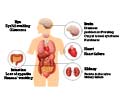A rapid screening method created using C. elegans to identify compounds that inhibit disease-causing amyloids.

Pervasive mislocalization of pathogenic coding variants underlying human disorders
Go to source). Amyloid proteins and peptides are linked to over 50 human diseases, including widespread neurodegenerative disorders such as Parkinson’s and Alzheimer’s, as well as rarer conditions like Huntington’s disease.
‘Did You Know?
Amyloidosis is a group of rare diseases caused by the accumulation of clumps of misfolded proteins, called amyloid fibrils, in organs and tissues. Without treatment, amyloidosis can result in organ failure and even death. #medindia #amyloids #amyloidosis’





Amyloidosis is a group of rare diseases caused by the accumulation of clumps of misfolded proteins, called amyloid fibrils, in organs and tissues. Without treatment, amyloidosis can result in organ failure and even death. #medindia #amyloids #amyloidosis’
Advertisement
Current Limitations in Amyloid Disease Treatments
“Environmental factors, genetic mutations and other unknown factors can cause amyloid proteins or peptides to clump inside or outside the cell, forming structures that incrementally increase in complexity,” said Muntasir Kamal, co-first author of the study and Ph.D. graduate of U of T’s Donnelly Centre for Cellular and Biomolecular Research. “These structures result in highly damaging protein aggregations, such as the Lewy bodies of Parkinson’s or the beta-amyloid plaques found in Alzheimer’s patients. Currently, there is no cure for diseases caused by amyloids, with existing therapies focused on symptom alleviation instead of prevention.”The study was published recently in the journal Nature Communications.
Advertisement
Targeting Amyloid Aggregation with Small Molecules
In an effort to treat amyloid-associated diseases, the research team worked towards finding small molecules that bind to amyloids — and thereby prevent them from binding to other molecules that can help them aggregate. An example of a compound that can do this is the Congo red dye used to stain amyloids that form in nematodes used for research.The team searched for additional compounds that outcompete aggregate-forming molecules in nematodes when it comes to binding to amyloids. The crucial difference between compounds that prevent amyloids from aggregating and those that help them do this is that the former are not able to grow into more complex structures. Instead, they function like a harmless placeholder in the space where the aggregate-forming molecules would attach.
Advertisement
Advantages of C. elegans Over Traditional Animal Models
Showing that the popular model system C. elegans could be used to screen small molecules for amyloid binders is an exciting breakthrough in the pursuit of treatments for diseases linked to amyloids. The reliability of the nematode screening system was confirmed for many of the newly discovered amyloid binders through in vitro experiments, indicating that the results of the study could potentially be applied to humans.“Most primary screens for amyloid binders have been conducted in cell-based or cell-free in vitro assays,” said Kamal. “When it comes to animal models, mice and rats are most commonly used to test experimental amyloid inhibitors. They both have their advantages, but neither compares to the free-living nematode C. elegans in terms of how quickly compounds can be screened with the worm model. It only takes one week to conduct an amyloid inhibitor screen with nematodes, which offer a more accurate representation of disease states than a petri dish.”
Future Goals in Neurodegenerative Disease Management
“We’ve developed a platform to rapidly screen compounds for amyloid growth suppressors,” said Peter Roy, principal investigator on the study and professor of molecular genetics at the Donnelly Centre and U of T’s Temerty Faculty of Medicine. “This platform can be used in preclinical studies to inform drug therapies. Ultimately, we hope to see results from testing amyloid binders in nematodes translate to treating neurodegenerative diseases in humans.”Reference:
- Pervasive mislocalization of pathogenic coding variants underlying human disorders - (https://www.cell.com/cell/abstract/S0092-8674(24)01021-3)
Source-Eurekalert












